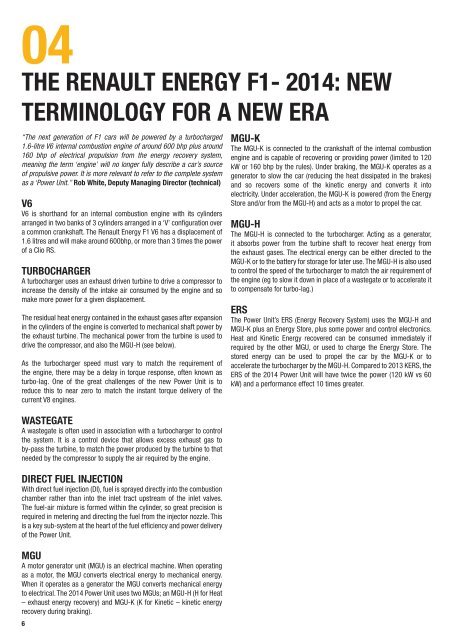THE ENERGY F1-2014 - Renault Sport
THE ENERGY F1-2014 - Renault Sport
THE ENERGY F1-2014 - Renault Sport
Create successful ePaper yourself
Turn your PDF publications into a flip-book with our unique Google optimized e-Paper software.
04<br />
<strong>THE</strong> RENAULT <strong>ENERGY</strong> <strong>F1</strong>- <strong>2014</strong>: NEW<br />
TERMINOLOGY FOR A NEW ERA<br />
‘‘The next generation of <strong>F1</strong> cars will be powered by a turbocharged<br />
1.6-litre V6 internal combustion engine of around 600 bhp plus around<br />
160 bhp of electrical propulsion from the energy recovery system,<br />
meaning the term ‘engine’ will no longer fully describe a car’s source<br />
of propulsive power. It is more relevant to refer to the complete system<br />
as a ‘Power Unit.’’ Rob White, Deputy Managing Director (technical)<br />
V6<br />
V6 is shorthand for an internal combustion engine with its cylinders<br />
arranged in two banks of 3 cylinders arranged in a ‘V’ configuration over<br />
a common crankshaft. The <strong>Renault</strong> Energy <strong>F1</strong> V6 has a displacement of<br />
1.6 litres and will make around 600bhp, or more than 3 times the power<br />
of a Clio RS.<br />
TURBOCHARGER<br />
A turbocharger uses an exhaust driven turbine to drive a compressor to<br />
increase the density of the intake air consumed by the engine and so<br />
make more power for a given displacement.<br />
The residual heat energy contained in the exhaust gases after expansion<br />
in the cylinders of the engine is converted to mechanical shaft power by<br />
the exhaust turbine. The mechanical power from the turbine is used to<br />
drive the compressor, and also the MGU-H (see below).<br />
As the turbocharger speed must vary to match the requirement of<br />
the engine, there may be a delay in torque response, often known as<br />
turbo-lag. One of the great challenges of the new Power Unit is to<br />
reduce this to near zero to match the instant torque delivery of the<br />
current V8 engines.<br />
WASTEGATE<br />
A wastegate is often used in association with a turbocharger to control<br />
the system. It is a control device that allows excess exhaust gas to<br />
by-pass the turbine, to match the power produced by the turbine to that<br />
needed by the compressor to supply the air required by the engine.<br />
DIRECT FUEL INJECTION<br />
With direct fuel injection (DI), fuel is sprayed directly into the combustion<br />
chamber rather than into the inlet tract upstream of the inlet valves.<br />
The fuel-air mixture is formed within the cylinder, so great precision is<br />
required in metering and directing the fuel from the injector nozzle. This<br />
is a key sub-system at the heart of the fuel efficiency and power delivery<br />
of the Power Unit.<br />
MGU<br />
A motor generator unit (MGU) is an electrical machine. When operating<br />
as a motor, the MGU converts electrical energy to mechanical energy.<br />
When it operates as a generator the MGU converts mechanical energy<br />
to electrical. The <strong>2014</strong> Power Unit uses two MGUs; an MGU-H (H for Heat<br />
– exhaust energy recovery) and MGU-K (K for Kinetic – kinetic energy<br />
recovery during braking).<br />
6<br />
MGU-K<br />
The MGU-K is connected to the crankshaft of the internal combustion<br />
engine and is capable of recovering or providing power (limited to 120<br />
kW or 160 bhp by the rules). Under braking, the MGU-K operates as a<br />
generator to slow the car (reducing the heat dissipated in the brakes)<br />
and so recovers some of the kinetic energy and converts it into<br />
electricity. Under acceleration, the MGU-K is powered (from the Energy<br />
Store and/or from the MGU-H) and acts as a motor to propel the car.<br />
MGU-H<br />
The MGU-H is connected to the turbocharger. Acting as a generator,<br />
it absorbs power from the turbine shaft to recover heat energy from<br />
the exhaust gases. The electrical energy can be either directed to the<br />
MGU-K or to the battery for storage for later use. The MGU-H is also used<br />
to control the speed of the turbocharger to match the air requirement of<br />
the engine (eg to slow it down in place of a wastegate or to accelerate it<br />
to compensate for turbo-lag.)<br />
ERS<br />
The Power Unit’s ERS (Energy Recovery System) uses the MGU-H and<br />
MGU-K plus an Energy Store, plus some power and control electronics.<br />
Heat and Kinetic Energy recovered can be consumed immediately if<br />
required by the other MGU, or used to charge the Energy Store. The<br />
stored energy can be used to propel the car by the MGU-K or to<br />
accelerate the turbocharger by the MGU-H. Compared to 2013 KERS, the<br />
ERS of the <strong>2014</strong> Power Unit will have twice the power (120 kW vs 60<br />
kW) and a performance effect 10 times greater.


